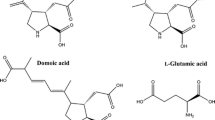Abstract
The brain is protected by a physiological blood-brain barrier (BBB) against toxins and some metabolites circulating in the blood. At the same time, the BBB limits penetration into the brain of many neuroactive drugs. Efficient ways to increase BBB permeability for delivery of drugs of different chemical nature into the brain are unknown. This work deals with delivery into the brain of 10−2 M dopamine, a substance that does not penetrate the BBB under normal circumstances. It was studied in two independent experiments: (i) penetration of 3H-labeled dopamine from its mixture with 10−5 M H2O2 into hypothalamus and striatum structures of intact rat brain, and (ii) effect of unlabeled dopamine from a mixture with H2O2 on the rat motor activity in a haloperidol catalepsy model. It was shown that (i) at the third minute after nasal application of the dopamine + H2O2 mixture, the dopamine level increases 45-fold in the hypothalamus and almost 30-fold in the striatum and (ii) motility of animals in the catalepsy haloperidol model is recovered 90 sec after intranasal introduction of dopamine. No such effects were observed after replacement of H2O2 by 0.9% NaCl solution. Thus, it was shown on the example of dopamine that its introduction into the nasal cavity simultaneously with H2O2 provides for rapid delivery of the drug into the brain. These results expand our knowledge concerning the biological role of exoROS in modulating BBB permeability and may contribute to the development of a new therapeutic strategy for neurological diseases.
Similar content being viewed by others
Abbreviations
- BBB:
-
blood-brain barrier
- DA:
-
dopamine
- DOPAC:
-
3,4-dihydroxyphenylacetic acid
- endoROS:
-
endogenous (metabolic) ROS
- exoROS:
-
exogenous ROS
- GS:
-
gaseous superoxide
- HBO:
-
hyperbaric oxygenation
- HPLC:
-
high performance liquid chromatography
- MAO-A and MAO-B:
-
monoamine oxidase A and B-respectively
- MPTP:
-
1-methyl-4-phenyl-1,2,3,6-tetrahydropyridine
- 6-OHDA:
-
6-hydroxydopamine
- ROS:
-
reactive oxygen species
- SOD:
-
superoxide dismutase
References
Halliwell, B., and Gutteridge, J. M. C. (1988) Hum. Toxicol., 7, 7–13.
Cohen, G. (1994) Ann. NY Acad. Sci., 738, 8–14.
McCord, J. M. (1993) Clin. Biochem., 26, 351–357.
McCord, J. M. (1995) PSEBM, 209, 112–117.
Longo, V. D., Mitteldorf, J., and Skulachev, V. P. (2005) Nat. Rev. Genet., 6, 866–872.
Goldstein, N. I., Goldstein, R. N., and Merzlyak, M. N. (1992) Int. J. Biometeorol., 36, 118–122.
Goldstein, N. I. (2000) Biophysical Aspects of the Exogenous Superoxide
 Physiological Effect on Animals: Doctoral dissertation [in Russian], Moscow State University, Moscow.
Physiological Effect on Animals: Doctoral dissertation [in Russian], Moscow State University, Moscow.Arsavskis, V., Goldsteins, N., Aroncika, B., Konstantinova, O., and Raits, E. (1991) Latvijas Arsts, 2, 77–80 (in Latvian).
Goldstein, N. I., Voskresenskaya, O. G., Dubynin, V. A., Levitskaya, N. G., and Kamensky, A. A. (2003) Byul. Eksp. Biol. Med., 135, 253–256.
Goldstein, N., Baumann, S., Lewin, T., Kamensky, A., Dubinin, V., and Konstantinova, O. (1996) Inflamm. Res., 5, 473–478.
Golubev, V. L., Sadekov, R. A., Pilipocich, A. A., and Goldstein, N. I. (2003) Lechenie Nervnykh Boleznei, 4, 26–30.
Goldstein, N. I., Naidin, V. L., and Fedorova, N. V. (2002) Neurol. J. (Moscow), 6, 45–48.
Abbott, N. J. (2000) Cell Mol. Neurobiol., 20, 131–147.
Miller, A. A., Drummond, G. R., and Sobey, C. G. (2006) Antioxid. Redox Signal., 8, 1113–1120.
Kang, Y. S. (2006) Adv. Exp. Med. Biol., 583, 291–298.
Faraci, F. M. (2006) J. Appl. Physiol., 100, 739–743.
Lee, H. S., Namkoong, K., Kim, D. H., Kim, K. J., Cheong, Y. H., Kim, S. S., Lee, W. B., and Kim, K. Y. (2004) Microvasc. Res., 68, 231–238.
Goldstein, N., and Goldstein, R. (2002) Patent DE 10248601.
Zolotarev, Yu. A., Dadayan, A. K., Borisov, Yu. A., and Kozik, V. S. (2010) Chem. Rev., 110, 5425–5446.
Ehrenstrom, F., and Johansson, P. (1985) Life Sci., 36, 867–879.
Levitskaya, N. G., Sebentsova, E. A., Andreeva, L. A., Alfeeva, L. Y., Kamenskii, A. A., and Myasoedov, N. F. (2004) Neurosci. Behav. Physiol., 34, 399–405.
Ashmarin, I. P., Levitskaya, N. G., Antonova, L. V., Nezavibatko, V. N., Alfeeva, L. Yu., Dubinin, V. A., Golubovich, V. P., Ponomareva-Stepnaya, M. A., and Kamensky, A. A. (1994) Regul. Pept., 51, 49–54.
Al-Ghananeem, A. M., Malkawi, A. H., and Crooks, P. A. (2011) Drug Dev. Ind. Pharm., 37, 329–334.
Haase, J., Killian, A. M., Magnani, F., and Williams, C. (2001) Biochem. Soc. Trans., 29, 722–728.
Tetrault, S., Chever, O., Sik, A., and Amzica, F. (2008) Eur. J. Neurosci., 28, 1330–1341.
Konofagou, E. E., Tung, Y. S., Choi, J., Deffieux, T., Baseri, B., and Vlachos, F. (2012) Curr. Pharm. Biotechnol., [Epub ahead of print].
Neuwelt, E. A., Bauer, B., Fahlke, C., Fricker, G., Iadecola, C., Janigro, D., Leybaert, L., Molnar, Z., O’Donnell, M. E., Povlishock, J. T., Saunders, N. R., Sharp, F., Stanimirovic, D., Watts, R. J., and Drewes, L. R. (2011) Nat. Rev. Neurosci., 12, 169–182.
Su, Y., and Sinko, P. J. (2006) Expert Opin. Drug Deliv., 3, 419–435.
Simansky, K. J., Bourbonais, K. A., and Smith, G. P. (1985) Pharmacol. Biochem. Behav., 23, 253–258.
Lagrange, P., Romero, I. A., Minn, A., and Revest, P. A. (1999) Free Radic. Biol. Med., 27, 667–672.
Goldstein, N. (2002) Biochemistry (Moscow), 67, 161–170.
McCorvy, J. D., Watts, V. J., and Nichols, D. E. (2012) Psychopharmacology (Berl.), January 6, [Epub ahead of print].
Author information
Authors and Affiliations
Corresponding author
Additional information
Original Russian Text © N. Goldstein, R. Goldstein, D. Terterov, A. A. Kamensky, G. I. Kovalev, Yu. A. Zolotarev, G. N. Avakyan, S. Terterov, 2012, published in Biokhimiya, 2012, Vol. 77, No. 5, pp. 525–532.
Rights and permissions
About this article
Cite this article
Goldstein, N., Goldstein, R., Terterov, D. et al. Blood-brain barrier unlocked. Biochemistry Moscow 77, 419–424 (2012). https://doi.org/10.1134/S000629791205001X
Received:
Revised:
Published:
Issue Date:
DOI: https://doi.org/10.1134/S000629791205001X





 Physiological Effect on Animals: Doctoral dissertation [in Russian], Moscow State University, Moscow.
Physiological Effect on Animals: Doctoral dissertation [in Russian], Moscow State University, Moscow.